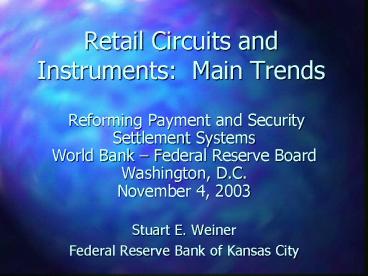Retail Circuits and Instruments: Main Trends - PowerPoint PPT Presentation
1 / 23
Title:
Retail Circuits and Instruments: Main Trends
Description:
Retail Circuits and Instruments: Main Trends Reforming Payment and Security Settlement Systems World Bank Federal Reserve Board Washington, D.C. – PowerPoint PPT presentation
Number of Views:125
Avg rating:3.0/5.0
Title: Retail Circuits and Instruments: Main Trends
1
Retail Circuits and Instruments Main Trends
- Reforming Payment and Security
- Settlement Systems
- World Bank Federal Reserve Board
- Washington, D.C.
- November 4, 2003
- Stuart E. Weiner
- Federal Reserve Bank of Kansas City
2
Introduction
- Payments systems worldwide are experiencing
rapid, unprecedented change - Key driving forces are evolving end-user needs,
technological advances, network integration,
increased cross-border payments - As retail payments systems develop and evolve,
how are the needs of end-users best met?
3
Terminology
- Retail versus wholesale
- Consumer retail payments
- Merchants
- Billers
- Business, government retail payments
4
Key Points
- To be successful, consumer retail payments
instruments and systems must meet three criteria - Safety
- Efficiency
- Accessibility
- Consumer/merchant/biller acceptance, in turn,
will help payments instruments and systems
achieve necessary critical mass
5
Presentation Structure
- Payments mix across countries
- Consumer/merchant/biller needs and preferences
- Critical mass
- Case studies
- Business needs
- Closing remarks
6
PaymentsCross-Country Snapshot2001
7
Payments Cross-Country Trends1997, 2001
8
Payments U.S. ACH Growth from New Sources 2002
2003
9
Consumer/Merchant/Biller Needs and Preferences
- Despite strikingly different retail payments
mixes across countries, all successful
instruments and systems meet three critical
criteria safety, efficiency, accessibility - There will often be tradeoffs among these three
characteristics - Distinction between instruments and systems
10
Safety
- Retail payments instruments must be perceived by
consumers, merchants, and billers to be safe and
reliable - Payments providers (banks, nonbanks, networks,
processors) thus have a strong incentive to
provide this safety - Providers may not, however, have an equally
strong incentive to provide this level of safety
at the macro level - Systemic and operational risk issues can arise
11
Efficiency
- Consumers, merchants, and billers want payments
methods that are low-cost and convenient - Providers will consequently have an incentive to
operate as efficiently as possible - Economies of scale and network economies (a
payments mechanism takes on more value to
existing users as more users elect to
participate) may lead to consolidation and
concentration among providers
12
Timeline of Regional ATM and Debit Card
Networks1972-2002
13
Accessibility
- Providers have an incentive to provide broad
access - But access need not be universal to be profitable
for providers - Two levels of access
- Front-line access by consumers, merchants,
billers - Infrastructure access by providers, making the
first level of access possible
14
U.S. Consumer Payments Choices Research Results
- Consumers are more likely to use electronic forms
of payment - the younger and more educated they are, and the
greater income they have - the more they use new technologies or computers
- Payment choice depends on characteristics of the
transaction, including transaction value,
physical characteristics of the point of sale,
and a bills frequency and value variability
15
Critical Mass
- A successful payments instrument must reach a
critical mass of users - To reach critical mass, must have consumer,
merchant, biller acceptance - Also, providers must ultimately find it
profitable to participate
16
Critical Mass (cont.)
- Reaching critical mass is important for two
reasons - Allows merchants, billers, and providers to cover
fixed costs - Allows network economies to be realized
(overcoming the chicken versus egg problem) - Private versus public provision
- Competitive-network model versus regulated-
monopoly model
17
U.S. Case Studies
- The three criteria (safety, efficiency, and
accessibility) and critical mass - Have successfully been met by credit cards, debit
cards, and ACH - Have unsuccessfully been met by digital cash
- Have met resistance but are attempting to take
hold in the P2P and EBPP markets
18
Business Payments Needs
- Same three criteria safety, efficiency,
accessibility - Two key efficiency considerations
- Internal technology integration (compatibility
with existing systems, i.e., straight-through
processing) - Common standards, interoperability across firms
- Same need for critical mass
- Need to make business case
19
U.S. Business Payments Study
- Federal Reserve study undertaken in
- 2001-2002
- Interviewed representatives of roughly fifty
organizations, including corporate end users,
technology firms, banks, and private-sector
providers - Sought views on longer-term payments system
developments
20
U.S. Business Payments Study (cont.)
- Corporations accounts payable, accounts
receivable, payments, and reconcilement systems
continue to be less integrated than necessary for
seamless handling of invoice and electronic
payments information. - The existence of multiple payment-message
formats, such as the formats for ACH, wire
transfers, and other electronic payments,
increases the cost and complexity of payments
processing.
21
Closing Remarks
- Payments instruments and systems are undergoing
dramatic, even profound, change - Meeting the needs of end-users will at times be
challenging, but those end-users will go a long
way in determining for themselves what will be
successful and what will not - Safety, efficiency, accessibility, and critical
mass will be key elements of success
22
References
- BIS, Statistics on Payment and Settlement
Systems in Selected Countries, 2003 - Bradford-Davies-Weiner, Nonbanks in the Payments
System, 2003. - Federal Reserve Board, The Future of Retail
Electronic Payments Systems, 2002 - Hayashi-Klee, Technology Adoption and Consumer
Payments, 2003. - Hayashi-Sullivan-Weiner, A Guide to the ATM and
Debit Card Industry, 2003. - Hoenig, Payments and Settlement Systems, BAI
Money Transfer Conference, 2000. - Stavins, Effect of Consumer Characteristics on
the Use of Payments Instruments, 2001.
23
Contact Information
- stuart.e.weiner_at_kc.frb.org
- Stuart E. Weiner
- Payments System Research
- Federal Reserve Bank of Kansas City
- 925 Grand Blvd.
- Kansas City, Missouri 64198 USA
- 816.881.2201































